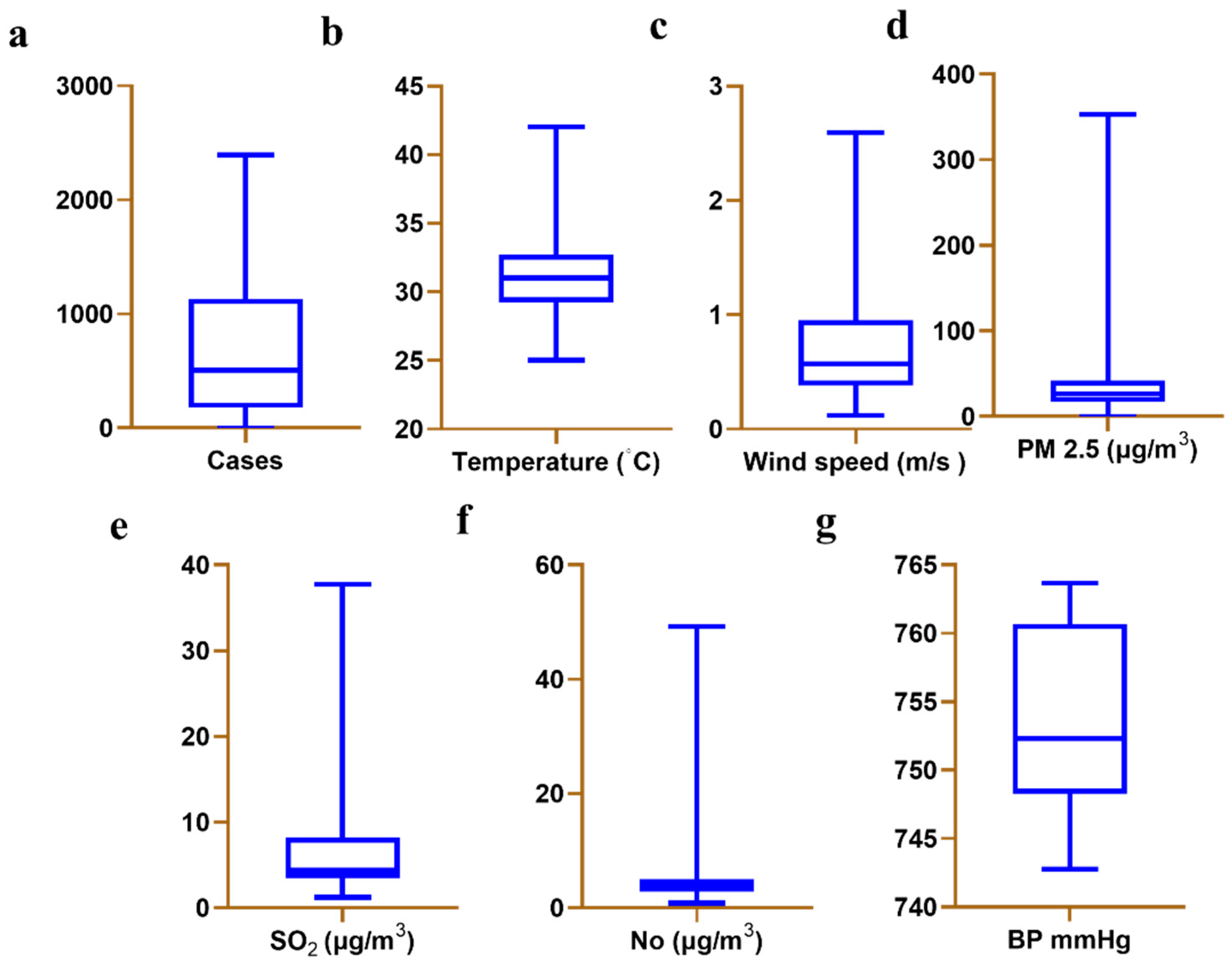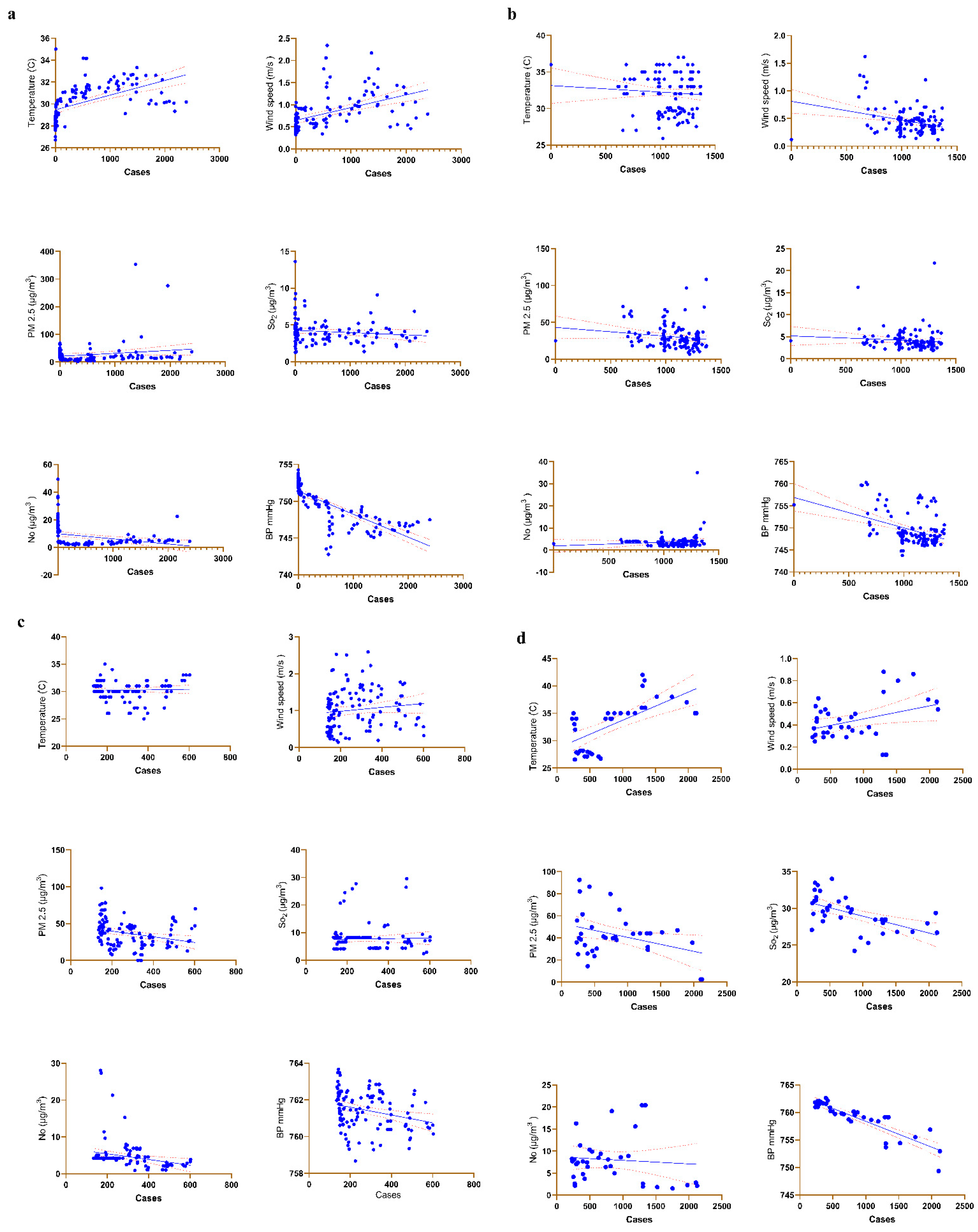Assessing the Impact of Meteorological Factors on COVID-19 Seasonality in Metropolitan Chennai, India
Abstract
:1. Introduction
2. Materials and Methods
2.1. Data on COVID-19 Incidence
2.2. Environmental Condition Data
2.3. Data Analysis
3. Results
3.1. Description of COVID-19 Outbreak, Temperature, Wind Speed, and Air Pollutants
3.2. Association between All Variables and COVID-19 Confirmed Cases
4. Discussion
4.1. Pollutant Levels during COVID-19 Pandemic
4.2. The Association between Meteorological Factors and Daily COVID-19 Cases
5. Conclusions
Supplementary Materials
Author Contributions
Funding
Institutional Review Board Statement
Informed Consent Statement
Data Availability Statement
Acknowledgments
Conflicts of Interest
References
- World Health Organization. Coronavirus Disease (COVID-2019), Situation Report; World Health Organization: Geneva, Switzerland, 2020. [Google Scholar]
- Ma, Y.; Zhao, Y.; Liu, J.; He, X.; Wang, B.; Fu, S.; Yan, J.; Niu, J.; Zhou, J.; Luo, B. Effects of temperature variation and humidity on the death of COVID-19 in Wuhan, China. Sci Total Environ. 2020, 724, 138226. [Google Scholar] [CrossRef] [PubMed]
- Wu, Y.; Jing, W.; Liu, J.; Ma, Q.; Yuan, J.; Wang, Y.; Du, M.; Liu, M. Effects of temperature and humidity on the daily new cases and new deaths of COVID-19 in 166 countries. Sci. Total Environ. 2020, 729, 139051. [Google Scholar] [CrossRef]
- Donnelly, C.A.; Ghani, A.C.; Leung, G.M.; Hedley, A.J.; Fraser, C.; Riley, S.; Abu-Raddad, L.J.; Ho, L.M.; Thach, T.Q.; Chau, P.; et al. Epidemiological determinants of spread of causal agent of severe acute respiratory syndrome in Hong Kong. Lancet 2003, 361, 1761–1766. [Google Scholar] [CrossRef] [Green Version]
- Nair, H.; Brooks, W.A.; Katz, M.; Roca, A.; Berkley, J.A.; Madhi, S.A.; Simmerman, J.M.; Gordon, A.; Sato, M.; Howie, S.; et al. Global burden of respiratory infections due to seasonal influenza in young children: A systematic review and meta-analysis. Lancet 2011, 378, 1917–1930. [Google Scholar] [CrossRef] [Green Version]
- Wallis, P.; Nerlich, B. Disease metaphors in new epidemics: The UK media framing of the 2003 SARS epidemic. Soc. Sci. Med. 2005, 60, 2629–2639. [Google Scholar] [CrossRef] [PubMed]
- Mourtzoukou, E.G.; Falagas, M.E. Exposure to cold and respiratory tract infections. Int. J. Tuberc. Lung Dis. 2007, 11, 938–943. [Google Scholar] [PubMed]
- Chan, K.H.; Peiris, J.S.M.; Lam, S.Y.; Poon, L.L.M.; Yuen, K.-Y.; Seto, W.H. The Effects of Temperature and Relative Humidity on the Viability of the SARS Coronavirus. Adv. Virol. 2011, 2011, 734690. [Google Scholar] [CrossRef]
- Park, J.E.; Son, W.S.; Ryu, Y.; Choi, S.B.; Kwon, O.; Ahn, I. Effects of temperature, humidity, and diurnal temperature range on influenza incidence in a temperate region. Influenza Other Respir Viruses 2020, 14, 11–18. [Google Scholar] [CrossRef] [Green Version]
- Qi, H.; Xiao, S.; Shi, R.; Ward, M.P.; Chen, Y.; Tu, W.; Su, Q.; Wang, W.; Wang, X.; Zhang, Z. COVID-19 transmission in Mainland China is associated with temperature and humidity: A time-series analysis. Sci. Total Environ. 2020, 728, 138778. [Google Scholar] [CrossRef]
- Yin, C.; Zhao, W.; Pereira, P. Meteorological factors’ effects on COVID-19 show seasonality and spatiality in Brazil. Environ. Res. 2022, 208, 112690. [Google Scholar] [CrossRef]
- Liu, X.; Huang, J.; Li, C.; Zhao, Y.; Wang, D.; Huang, Z.; Yang, K. The role of seasonality in the spread of COVID-19 pandemic. Environ. Res. 2021, 195, 110874. [Google Scholar] [CrossRef]
- Yang, X.D.; Li, H.L.; Cao, Y.E. Influence of meteorological factors on the COVID-19 transmission with season and geographic location. Int. J. Environ. Res. Public Health 2021, 18, 484. [Google Scholar] [CrossRef] [PubMed]
- Nottmeyer, L.N.; Sera, F. Influence of temperature, and of relative and absolute humidity on COVID-19 incidence in England-a multi-city time-series study. Environ. Res. 2021, 196, 110977. [Google Scholar] [CrossRef] [PubMed]
- Smit, A.J.; Fitchett, J.M.; Engelbrecht, F.A.; Scholes, R.J.; Dzhivhuho, G.; Sweijd, N.A. Winter is coming: A southern hemisphere perspective of the environmental drivers of SARS-CoV-2 and the potential seasonality of COVID-19. Int. J. Environ. Res. Publ. Health 2020, 17, 5634. [Google Scholar] [CrossRef] [PubMed]
- CMDA. Second Master Plan for Chennai Metropolitan Area 2026 Chennai Metropolitan Development Authority; CMDA: Chennai, India, 2008.
- Laxminarayan, R.; Wahl, B.; Dudala, S.R.; Gopal, K.; Mohan, B.C.; Neelima, S.; Jawahar Reddy, K.S.; Radhakrishnan, J.; Lewnard, J.A. Epidemiology and transmission dynamics of COVID-19 in two Indian states. Science 2020, 370, 691–697. [Google Scholar] [CrossRef] [PubMed]
- Li, L.; Yang, L.; Zhang, L.J.; Jiang, Y. Numerical study on the impact of ground heating and ambient wind speed on flow fields in street canyons. Adv. Atmos. Sci. 2012, 29, 1227–1237. [Google Scholar] [CrossRef]
- WHO. Ambient (Outdoor) Air Pollution. 2018. Available online: https://www.who.int/news-room/fact-sheets/detail/ambient-(outdoor)-air-quality-and-health (accessed on 1 November 2021).
- Raj, M.G.; Karthikeyan, S.; Raj, M.G.; Karthikeyan, S. Effect of modes of transportation on commuters’ exposure to fine particulate matter (PM 2.5) and nitrogen dioxide (NO2) in Chennai, India. Environ. Eng. Res. 2019, 25, 898–907. [Google Scholar] [CrossRef]
- Sarkar, S. Engendering Trafficking and Human Security: A Comparative Study of India and Hungary. Int. J. Dev. Res. Quant. Tech. 2011, 1, 25–42. [Google Scholar]
- Al-Hurban, A.; Khader, S.; Alsaber, A.; Pan, J. Air Quality Assessment in the State of Kuwait during 2012 to 2017. Atmosphere 2021, 12, 678. [Google Scholar] [CrossRef]
- Atmospheric Pressure. Available online: http://www.britannica.com/EBchecked/topic/41486/atmospheric-pressure (accessed on 13 July 2022).
- Cucinotta, D.; Vanelli, M. WHO declares COVID-19 a pandemic. Acta Bio Med. Atenei Parm. 2020, 91, 157. [Google Scholar]
- Roy, S. Physicians’ Dilemma of False-Positive RT-PCR for COVID-19: A Case Report. SN Compr. Clin. Med. 2021, 3, 255–258. [Google Scholar] [CrossRef]
- Liu, J.; Zhou, J.; Yao, J.; Zhang, X.; Li, L.; Xu, X.; He, X.; Wang, B.; Fu, S.; Niu, T.; et al. Impact of meteorological factors on the COVID-19 transmission: A multi-city study in China. Sci. Total Environ. 2020, 726, 138513. [Google Scholar] [CrossRef] [PubMed]
- Tosepu, R.; Gunawan, J.; Effendy, D.S.; Lestari, H.; Bahar, H.; Asfian, P. Correlation between weather and COVID-19 pandemic in Jakarta, Indonesia. Sci. Total Environ. 2020, 725, 138436. [Google Scholar] [CrossRef] [PubMed]
- Ismail, I.M.; Rashid, M.I.; Ali, N.; Altaf, B.A.S.; Munir, M. Temperature, humidity and outdoor air quality indicators influence COVID-19 spread rate and mortality in major cities of Saudi Arabia. Environ. Res. 2022, 204, 112071. [Google Scholar] [CrossRef] [PubMed]
- Tantrakarnapa, K.; Bhopdhornangkul, B.; Nakhaapakorn, K. Influencing factors of COVID-19 spreading: A case study of Thailand. J. Public Health 2020, 30, 621–627. [Google Scholar] [CrossRef] [PubMed]
- Pani, S.K.; Lin, N.H.; RavindraBabu, S. Association of COVID-19 pandemic with meteorological parameters over Singapore. Sci. Total Environ. 2020, 740, 140112. [Google Scholar] [CrossRef]
- Bashir, M.F.; Ma, B.; Bilal Komal, B.; Bashir, M.A.; Tan, D.; Bashir, M. Correlation between climate indicators and COVID-19 pandemic in New York, USA. Sci. Total Environ. 2020, 728, 138835. [Google Scholar] [CrossRef]
- Ahmadi, M.; Sharifi, A.; Dorosti, S.; Jafarzadeh Ghoushchi, S.; Ghanbari, N. Investigation of effective climatology parameters on COVID-19 outbreak in Iran. Sci. Total Environ. 2020, 729, 138705. [Google Scholar] [CrossRef]
- Rosario, D.K.A.; Mutz, Y.S.; Bernardes, P.C.; Conte-Junior, C.A. Relationship between COVID-19 and weather: Case study in a tropical country. Int. J. Hyg. Environ. Health 2020, 229, 113587. [Google Scholar] [CrossRef]
- Feng, S.; Gao, D.; Liao, F.; Zhou, F.; Wang, X. The health effects of ambient PM2. 5 and potential mechanisms. Ecotoxicol. Environ. Saf. 2016, 128, 67–74. [Google Scholar] [CrossRef] [PubMed]
- Lindsley, W.; Blachere, F.M.; Thewlis, R.E.; Vishnu, A.; Davis, K.A.; Cao, G.; Palmer, J.E.; Clark, K.E.; Fisher, M.A.; Khakoo, R.; et al. Measurements of Airborne Influenza Virus in Aerosol Particles from Human Coughs. PLoS ONE 2010, 5, e15100. [Google Scholar] [CrossRef]
- Xian, M.; Ma, S.; Wang, K.; Lou, H.; Wang, Y.; Zhang, L.; Wang, C.; Akdis, C.A. Particulate matter 2.5 causes deficiency in barrier integrity in human nasal epithelial cells. Allergy Asthma Immunol. Res. 2020, 12, 56–71. [Google Scholar] [CrossRef] [PubMed] [Green Version]
- Lolli, S.; Chen, Y.C.; Wang, S.H.; Vivone, G. Impact of meteorological conditions and air pollution on COVID-19 pandemic transmission in Italy. Sci. Rep. 2020, 10, 16213. [Google Scholar] [CrossRef] [PubMed]
- Zoran, M.A.; Savastru, R.S.; Savastru, D.M.; Tautan, M.N. Assessing the relationship between surface levels of PM2.5 and PM10 particulate matter impact on COVID-19 in Milan, Italy. Sci. Total Environ. 2020, 738, 139825. [Google Scholar] [CrossRef] [PubMed]
- Sangkham, S.; Thongtip, S.; Vongruang, P. Influence of air pollution and meteorological factors on the spread of COVID-19 in the Bangkok metropolitan region and air quality during the outbreak. Environ Res. 2021, 197, 111104. [Google Scholar] [CrossRef] [PubMed]
- United States Environmental Protection Agency. NAAQS Table. 2016. Available online: https://www.epa.gov/criteria-air-pollutants/naaqs-table (accessed on 25 June 2022).
- Aidoo, E.N.; Adebanji, A.O.; Awashie, G.E.; Appiah, S.K. The effects of weather on the spread of COVID-19: Evidence from Ghana. Bull. Natl. Res. Cent. 2021, 45, 20. [Google Scholar] [CrossRef]



| Cases | Temperature | Wind Speed | PM 2.5 | SO2 | NO | Bar Pressure | |
|---|---|---|---|---|---|---|---|
| number of values | 402 | 402 | 402 | 402 | 402 | 402 | 402 |
| minimum | 0.000 | 25.00 | 0.1200 | 0.000 | 1.260 | 0.8900 | 742.8 |
| 25% percentile | 176.0 | 29.25 | 0.3800 | 17.23 | 3.508 | 2.838 | 748.3 |
| median | 509.5 | 31.00 | 0.5700 | 26.34 | 4.370 | 4.155 | 752.4 |
| 75% percentile | 1131 | 32.72 | 0.9525 | 42.30 | 8.190 | 5.075 | 760.8 |
| maximum | 2393 | 42.00 | 2.590 | 353.2 | 34.02 | 49.27 | 763.7 |
| range | 2393 | 17.00 | 2.470 | 353.2 | 32.76 | 48.38 | 20.89 |
| mean | 658.0 | 31.07 | 0.7279 | 32.31 | 7.512 | 5.697 | 754.0 |
| std. deviation | 534.9 | 2.591 | 0.4745 | 27.45 | 7.834 | 5.936 | 6.200 |
| std. error of mean | 26.68 | 0.1292 | 0.02367 | 1.369 | 0.3907 | 0.2961 | 0.3092 |
| sum | 264,535 |
| 1 March 2020, to 30 June 2020 | 1 July 2020, to 31 October 2020 | 1 November 2020, to 28 February 2021 | 1 March 2021, to 6 April 2021 | |||||
|---|---|---|---|---|---|---|---|---|
| Variables | Slope | R2 | Slope | R2 | Slope | R2 | Slope | R2 |
| temperature | 0.0002010 **** | 0.2691 | 0.001126 | 0.005129 | 0.001151 | 0.001794 | 0.001004 **** | 0.4272 |
| wind speed | 0.00004836 **** | 0.2278 | 0.00009834 *** | 0.02256 | 0.0003886 | 0.01517 | 0.00005209 * | 0.1285 |
| PM 2.5 | 0.005438 | 0.03118 | 0.007116 | 0.007495 | 0.01263 ** | 0.07301 | 0.005601 * | 0.1272 |
| SO2 | 0.0002346 | 0.01443 | 0.0009985 | 0.007495 | 0.003445 | 0.0006598 | 0.0005683 *** | 0.3177 |
| NO | 0.001098 *** | 0.08785 | 0.001365 | 0.01255 | 0.002596 ** | 0.06935 | 0.001646 | 0.006817 |
| BP | 0.00023112 **** | 0.6027 | 0.001412 **** | 0.1648 | 0.0006967 ** | 0.07248 | 0.0004261 **** | 0.7758 |
Publisher’s Note: MDPI stays neutral with regard to jurisdictional claims in published maps and institutional affiliations. |
© 2022 by the authors. Licensee MDPI, Basel, Switzerland. This article is an open access article distributed under the terms and conditions of the Creative Commons Attribution (CC BY) license (https://creativecommons.org/licenses/by/4.0/).
Share and Cite
Suman, T.Y.; Keerthiga, R.; Remya, R.R.; Jacintha, A.; Jeon, J. Assessing the Impact of Meteorological Factors on COVID-19 Seasonality in Metropolitan Chennai, India. Toxics 2022, 10, 440. https://doi.org/10.3390/toxics10080440
Suman TY, Keerthiga R, Remya RR, Jacintha A, Jeon J. Assessing the Impact of Meteorological Factors on COVID-19 Seasonality in Metropolitan Chennai, India. Toxics. 2022; 10(8):440. https://doi.org/10.3390/toxics10080440
Chicago/Turabian StyleSuman, Thodhal Yoganandham, Rajendiran Keerthiga, Rajan Renuka Remya, Amali Jacintha, and Junho Jeon. 2022. "Assessing the Impact of Meteorological Factors on COVID-19 Seasonality in Metropolitan Chennai, India" Toxics 10, no. 8: 440. https://doi.org/10.3390/toxics10080440






